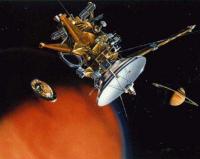ICEINSPACE
|
Moon Phase
CURRENT MOON
Waning Gibbous 94.8%
|

|
 |
| Huygens Ready for Release |
|
|
 |  |
 |
 | 
Click to Enlarge
Image Credit: NASA/JPL
 |
The highlights of the first year of the Cassini-Huygens mission to Saturn can be broken into two chapters: first, the arrival of the Cassini orbiter at Saturn in June, and second, the release of the Huygens probe on Dec. 24, 2004, on a path toward Titan.
Artist's concept of Cassini releasing the Huygens probe to Titan.
The Huygens probe, built and managed by the European Space Agency (ESA), is bolted to Cassini and fed electrical power through an umbilical cable. It has been riding along during the nearly seven-year journey to Saturn largely in a "sleep" mode, awakened every six months for three-hour instrument and engineering checkups. In three days, it will be cut loose from its mother ship and will coast toward Saturn's moon Titan, arriving on Jan. 14, 2005.
"As partners with ESA, one of our obligations was to carry the Huygens probe to Saturn and drop it off at Titan," said Robert T. Mitchell, Cassini program manager at NASA's Jet Propulsion Laboratory, Pasadena, Calif. "We've done the first part, and on Christmas Eve we will release Huygens and tension-loaded springs will gently push it away from Cassini onto a ballistic free-fall path to Titan."
Once freed from Cassini, the Huygens probe will remain dormant until the onboard timer wakes it up shortly before the probe reaches Titan's upper atmosphere on Jan. 14. Then it will begin a dramatic plunge through Titan's murky atmosphere, tasting the chemical makeup and composition as it descends to touch down on its surface. The data gathered during this 2-1/2 hour descent will be transmitted from the probe to the Cassini orbiter. Afterward, Cassini will point its antenna to Earth and relay the data through NASA's Deep Space Network to JPL and on to ESA's Space Operations Center in Darmstadt, Germany, which serves as the operations center for the Huygens probe mission. From this control center, ESA engineers will be tracking the probe and scientists will be standing by to process the data from the probe's six instruments.
Currently, both the orbiter and the probe are on an impact trajectory with Titan. This is the only way to ensure that Cassini delivers the probe in the right location. A confirmation of successful release is expected to be received from NASA's Deep Space Network tracking stations at Madrid, Spain and Goldstone, Calif., shortly before 8:00 p.m. PST on Dec. 24. A team of JPL engineers and ESA mission managers will be monitoring spacecraft activities at JPL during the release phase of the mission.
On Dec. 27, the Cassini orbiter will perform a deflection maneuver to keep it from following Huygens into Titan's atmosphere. This maneuver will also establish the required geometry between the probe and the orbiter for radio communications during the probe descent.
Two of the instruments on ESA's Huygens probe, the descent imager and spectral radiometer camera and the gas chromatograph-mass spectrometer, are contributions from NASA and American academia.
The imaging camera will take advantage of the Huygens probe's rotation, using two imagers to observe the surface of Titan during the late stages of descent for a view of the regions around the impact site. A side-looking imager will view the horizon and the underside of any cloud deck. More than just a camera, the instrument is designed to measure concentrations of argon and methane in the atmosphere and determine the size and density of particles. The instrument will also determine if the local surface is a solid or liquid, and if solid, its topography. The principal investigator is Dr. Martin G. Tomasko of the University of Arizona, Tucson, Ariz.
Although Titan's atmosphere is primarily nitrogen and methane, scientists believe it contains many other gases that are present only in small amounts. These trace gases can reveal critical details about the origin and evolution of Titan's atmosphere. Because trace gases are rare, they are difficult or impossible to observe remotely, so direct measurements must be made.
The gas chromatograph-mass spectrometer instrument will sample gas directly from Titan's atmosphere as the Huygens probe descends by parachute. Data from the instrument will allow researchers to investigate the chemical composition, origin and evolution of the atmosphere of Titan. The instrument was designed and built by NASA's Goddard Space Flight Center, Greenbelt, Md., and is led by the principal investigator, Dr. Hasso Niemann.
Updates on the Huygens probe release will be available at: http://saturn.jpl.nasa.gov and http://www.nasa.gov/cassini . The Cassini-Huygens mission is a cooperative project of NASA, the European Space Agency and the Italian Space Agency. JPL, a division of the California Institute of Technology in Pasadena, manages the Cassini mission for NASA's Science Mission Directorate, Washington, D.C. JPL designed, developed and assembled the Cassini orbiter. The European Space Agency built and managed the development of the Huygens probe and is in charge of the probe operations. The Italian Space Agency provided the high-gain antenna, much of the radio system and elements of several of Cassini's science instruments.
Original Source: Universe Today
|
 |
|